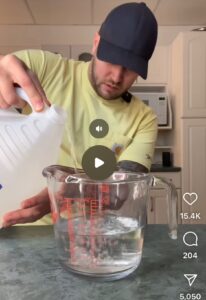Window Cleaning Solution with Rinse Aid
This easy DIY window cleaning project will transform your dirty, streaky windows into crystal-clear glass that allows maximum natural light into your home. Perfect for seasonal home maintenance, this method eliminates streaks and grime that regular cleaners often leave behind.
Tools and Materials
- Spray bottle
- Microfiber cloth or squeegee
- 2 cups of water
- 1/2 cup white vinegar
- 1 tablespoon dish soap
- 1 tablespoon rinse aid (like Finish Jet Dry or generic equivalent)
- Small funnel (optional for pouring)
- Step ladder (for higher windows)
Preparation
Before beginning, ensure you’re wearing clothes that can handle potential splashes from your cleaning solution. Remove any window treatments or obstacles that might get in your way. For exterior windows, choose a cloudy day if possible, as direct sunlight can cause the solution to dry too quickly and leave streaks.
Pro Tip If cleaning both sides of windows, plan to work on one side with horizontal wiping motions and the other with vertical motions to easily identify which side streaks might appear on.
Step By Step
Step-by-Step Instructions
- Find an empty spray bottle and remove any existing labels if you’re reusing one.
- Pour 2 cups of water into the spray bottle using a funnel if needed.
Pro Tip: Using distilled water instead of tap water can further reduce streaking, especially if you have hard water.
- Add 1/2 cup of white vinegar to the water.
- Add 1 tablespoon of dish soap to the mixture.
- Add 1 tablespoon of rinse aid (like Finish Jet Dry) to the solution. This is the secret ingredient that prevents streaking.
Pro Tip: The rinse aid breaks the surface tension of water and helps the solution evaporate evenly, which is why it’s so effective at preventing streaks.
- Secure the spray nozzle and gently shake the bottle to mix all ingredients thoroughly without creating too many bubbles.
- Spray the solution generously onto the window surface, ensuring complete coverage of all dirty areas.
Safety Warning: When cleaning windows above ground level, make sure your ladder is stable and positioned on level ground. Never overreach – it’s better to move the ladder than risk falling.
- Using your microfiber cloth or squeegee, wipe the window in a consistent pattern. For a squeegee, start at the top and pull down in a straight motion, wiping the blade after each pass.
- For particularly dirty windows, you may need to apply a second application and wipe again.
- Check your work by looking at the window from different angles to spot any remaining streaks or missed spots.
Troubleshooting
Problem: Still seeing streaks – Make sure you’re using enough rinse aid in your mixture and that you’re using a clean microfiber cloth or squeegee blade. Cotton cloths or paper towels can leave lint behind.
Problem: Solution leaving residue – You may have used too much dish soap. Try diluting your solution with a bit more water or making a fresh batch with less soap.
Problem: Stubborn spots remaining – For hard water deposits or bird droppings, you may need to pre-treat these areas. Apply the solution directly and let it sit for 5-10 minutes before scrubbing gently with a soft brush.
Problem: Exterior windows too high to reach – Consider investing in an extension pole with a squeegee attachment, or for a temporary solution, attach your microfiber cloth to a broom handle with rubber bands.
Additional Considerations
For winter cleaning in colder climates, add a small amount of rubbing alcohol to your mixture to prevent freezing and help cut through the particular grime that builds up during winter months. This also helps the solution evaporate more quickly in cold weather.
If you’re environmentally conscious, you can substitute the commercial rinse aid with a few drops of essential oil like lemon or orange, which contains natural citrus oils that help break surface tension. The results won’t be quite as streak-free, but they’re still impressive for an all-natural alternative.
Make this window cleaning solution in larger batches and store it for up to a month in a cool, dark place. Just give it a gentle shake before each use. For related projects, consider cleaning your window screens while you have your supplies out – just use the same solution and rinse thoroughly with a garden hose.
For maximum effectiveness, add this window cleaning to your seasonal home maintenance schedule. Clean windows not only improve your home’s appearance but also allow more natural light in, which can help reduce energy costs and improve your mood, especially during darker winter months.
Follow Jorey Tessier on Instagram for more household and cooking tips.
